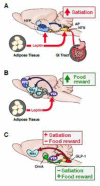Neural integration of satiation and food reward: role of GLP-1 and orexin pathways
- PMID: 24650552
- PMCID: PMC4167985
- DOI: 10.1016/j.physbeh.2014.03.013
Neural integration of satiation and food reward: role of GLP-1 and orexin pathways
Abstract
Central nervous system control of food intake involves detecting, integrating and responding to diverse internal and external signals. For maintenance of energy homeostasis, the brain uses long-term signals of metabolic status and short-term signals related to the nutrient content of individual meals. Feeding is also clearly influenced by hedonic, reward-related factors: palatability, motivation, and learned associations and cues that predict the availability of food. Different neural circuits have been proposed to mediate these homeostatic and hedonic aspects of eating. This review describes research on neural pathways that appear to be involved in both, integrating gastrointestinal satiation signaling with food reward. First, the glucagon-like peptide 1 projections from the nucleus of the solitary tract to the nucleus accumbens and ventral tegmental area are discussed as a mechanism through which meal-related gut signals may influence palatability, motivation for food, and meal size. Second, the orexin projection from lateral hypothalamus to the nucleus of the solitary tract and area postrema is discussed as a mechanism through which cues that predict rewarding food may act to increase motivation for food and also to suppress satiation. Additional potential integrative sites and pathways are also briefly discussed. Based on these findings, it is suggested that the brain circuitry involved in energy homeostasis and the circuitry mediating food reward are, in fact, overlapping and far less distinct than previously considered.
Keywords: Food reward; Glucagon-like peptide 1; Orexin; Satiation.
Copyright © 2014 Elsevier Inc. All rights reserved.
Figures

Similar articles
-
Ghrelin and Orexin Interact to Increase Meal Size Through a Descending Hippocampus to Hindbrain Signaling Pathway.Biol Psychiatry. 2020 Jun 1;87(11):1001-1011. doi: 10.1016/j.biopsych.2019.10.012. Epub 2019 Oct 29. Biol Psychiatry. 2020. PMID: 31836175 Free PMC article.
-
Endogenous hindbrain glucagon-like peptide-1 receptor activation contributes to the control of food intake by mediating gastric satiation signaling.Endocrinology. 2009 Jun;150(6):2654-9. doi: 10.1210/en.2008-1479. Epub 2009 Mar 5. Endocrinology. 2009. PMID: 19264875 Free PMC article.
-
Hedonic Eating and the "Delicious Circle": From Lipid-Derived Mediators to Brain Dopamine and Back.Front Neurosci. 2018 Apr 24;12:271. doi: 10.3389/fnins.2018.00271. eCollection 2018. Front Neurosci. 2018. PMID: 29740277 Free PMC article. Review.
-
A role for lateral hypothalamic orexin neurons in reward seeking.Nature. 2005 Sep 22;437(7058):556-9. doi: 10.1038/nature04071. Epub 2005 Aug 14. Nature. 2005. PMID: 16100511
-
Intestinal glucagon-like peptide-1 effects on food intake: Physiological relevance and emerging mechanisms.Peptides. 2020 Sep;131:170342. doi: 10.1016/j.peptides.2020.170342. Epub 2020 Jun 6. Peptides. 2020. PMID: 32522585 Review.
Cited by
-
Gastric Sensory and Motor Functions and Energy Intake in Health and Obesity-Therapeutic Implications.Nutrients. 2021 Apr 1;13(4):1158. doi: 10.3390/nu13041158. Nutrients. 2021. PMID: 33915747 Free PMC article. Review.
-
Modulation of Food Reward by Endocrine and Environmental Factors: Update and Perspective.Psychosom Med. 2015 Jul-Aug;77(6):664-70. doi: 10.1097/PSY.0000000000000146. Psychosom Med. 2015. PMID: 25738439 Free PMC article. Review.
-
Blaming the Brain for Obesity: Integration of Hedonic and Homeostatic Mechanisms.Gastroenterology. 2017 May;152(7):1728-1738. doi: 10.1053/j.gastro.2016.12.050. Epub 2017 Feb 10. Gastroenterology. 2017. PMID: 28192106 Free PMC article. Review.
-
Rational Design by Structural Biology of Industrializable, Long-Acting Antihyperglycemic GLP-1 Receptor Agonists.Pharmaceuticals (Basel). 2022 Jun 13;15(6):740. doi: 10.3390/ph15060740. Pharmaceuticals (Basel). 2022. PMID: 35745659 Free PMC article.
-
Liraglutide suppression of caloric intake competes with the intake-promoting effects of a palatable cafeteria diet, but does not impact food or macronutrient selection.Physiol Behav. 2017 Aug 1;177:4-12. doi: 10.1016/j.physbeh.2017.03.045. Epub 2017 Mar 30. Physiol Behav. 2017. PMID: 28366815 Free PMC article.
References
Publication types
MeSH terms
Substances
Grants and funding
LinkOut - more resources
Full Text Sources
Other Literature Sources

